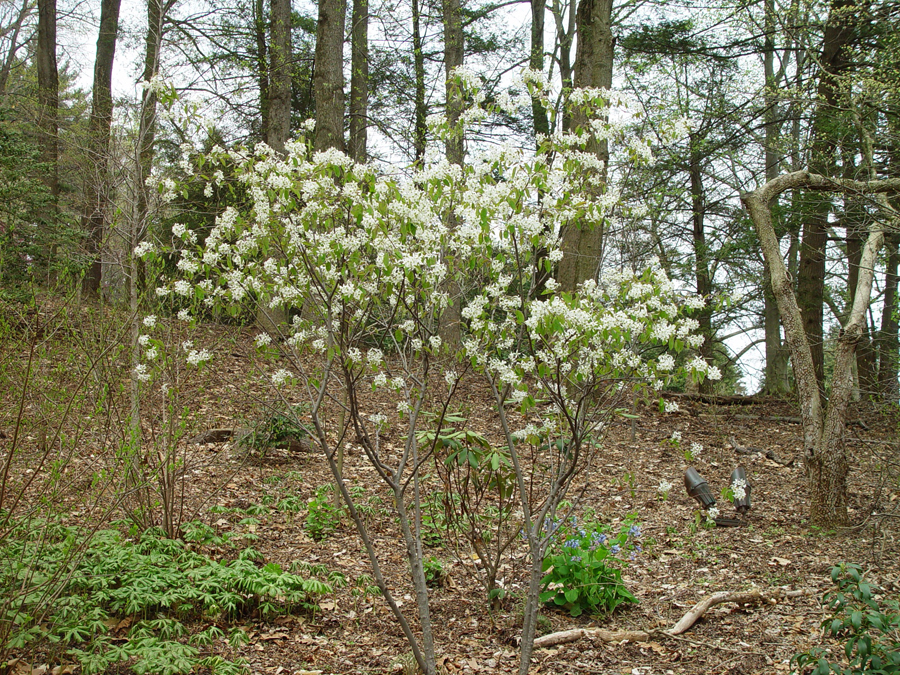Amelanchier x grandiflora ‘Autumn Brilliance’
 Latin name: Amelanchier x grandiflora ‘Autumn Brilliance’
Latin name: Amelanchier x grandiflora ‘Autumn Brilliance’
Common name: Apple serviceberry
Flowers: White, small, April 12
Fruit or cones: Edible fruits (3/8” diameter) 12
Height & Width: 15 to 25ft 12
Type: Deciduous tree 12
Habit: Multi-trunked understory tree 12
Wetland indicator category**: FACU, FAC 16
Texture: Medium 12
Growth rate: Moderate 12
Light: Full sun to part shade 12
Moisture: Average, dry, moist 20
Soil*: Acidic, adaptable 20
Zones: 4 to 9 12
Origin: L48, AK, SPM, CAN 16
Ecosystem benefits: Attracts birds 12
Features: The Serviceberry is a wonderful multi-trunked understory tree. It has white flowers that bloom in April. It also has beautiful fall color. Fall color includes oranges, yellows, and reds. It has blueberry like edible fruits that are about 3/8” in diameter. It attracts many organisms, one of those being birds 12.
Siting: Attractive understory tree for lawns, shrub borders, woodland margins, or native plant areas. Good plant for bird gardens 12.
Care: Plant so root flare is visible at soil surface 14. At planting, water the root ball daily with two gallons of water per inch of trunk diameter for two weeks, every other day for two months and then weekly until established. Modify water recommendations to reflect site drainage and rainfall. Apply 3” of mulch over the planted area. Do not allow mulch to touch the trunk 14.
Pests: No serious insect or disease problems. Rust, leaf spot, fire blight, powdery mildew and canker are occasional disease problems 12.
This plant does not appear on the following invasive plant lists on 2/13/2023:
X USDA SC Invasive Plant Species
X SC Exotic Plant Pest Council
Author: Marie Aull
Image source: Mt. Cuba Center (https://mtcubacenter.org/plants/autumn-brilliance-serviceberry/)
Sources:
- Armitage, A. (2001). Armitage’s manual of annuals, biennials, and half-hardy perennials. Portland, OR: Timber Press.
- Armitage, A. (2006). Armitage’s native plants for North American gardens. Portland, Oregon: Timber Press.
- Armitage, A. (2008). Herbaceous perennial plants: A treatise on their identification, culture, and garden attributes. Athens, GA: University of Georgia.
- Clemson Cooperative Extension Home and Garden Information Center.(2011). Flowers fact sheets. Retrieved from https://hgic.clemson.edu/category/flowers/
- Clemson Cooperative Extension Home and Garden Information Center.(2011). Groundcovers & vines fact sheets. Retrieved from https://hgic.clemson.edu/category/groundcovers/
- Clemson Cooperative Extension Home and Garden Information Center.(2011). Trees. Retrieved from https://hgic.clemson.edu/category/trees/
- Clemson Cooperative Extension Home and Garden Information Center.(2011). Shrubs. Retrieved from https://hgic.clemson.edu/category/shrubs/
- Dirr, M. A. (2009). Manual of woody landscape plants. Champaign, IL: Stipes Publishing.
- Gilman, E. F. (1997). Trees for urban and suburban landscapes. Albany, NY: Delmar Publishers.
- Lady Bird Johnson Wildflower Center University of Texas at Austin. (2012). Native plant information network. Retrieved from http://www.wildflower.org/explore/
- McMillan, P., Plant taxonomist Clemson University, personal communication.
- Missouri Botanical Garden Kemper Center for Home Gardening. Plant finder. Retrieved from http://www.mobot.org/gardeninghelp/plantfinder/Alpha.asp
- North Carolina State University (2005). Plant fact sheets. Retrieved from http://www.ces.ncsu.edu/depts/hort/consumer/factsheets/index.html
- Strother, E. V., Ham, D. L., Gilland, L. (2003) Urban tree species guide: Choosing the right tree for the right place. Columbia, SC: South Carolina Forestry Commission.
- University of Florida, IFAS Extension. (2011). Southern trees fact sheet. Retrieved from http://edis.ifas.ufl.edu/department_envhort-trees
- USDA . Plant profile. (n/d).Retrieved from http://plants.usda.gov/java/
- USDA. Plant wetland indicator status. (n/d). Retrieved from http://plants.usda.gov/wetland.html
- Vincent, E., Environmental horticulturist Clemson University, personal communication.
- Clemson Extension. Carolina Yards Plant Database. Retrieved from https://www.clemson.edu/extension/carolinayards/plant-database/index.htm
- Mt. Cuba Center. Autumn brilliance serviceberry. (2016, July 1). Retrieved February 13, 2023, from https://mtcubacenter.org/plants/autumn-brilliance-serviceberry/
*Soil pH is determined using a professional soil test. Contact your Clemson University County Extension service for assistance www.clemson.edu/extension/. Click on “local offices”.
**2012 Plant Wetland Indicator categories (quantitative derived) http://plants.usda.gov/wetinfo.html
| Indicator Code | Indicator Status | Comment |
|---|---|---|
| OBL | Obligate Wetland | Almost always is a hydrophyte, rarely in uplands |
| FACW | Facultative Wetland | Usually is a hydrophyte but occasionally found in uplands |
| FAC | Facultative | Commonly occurs as either a hydrophyte or non-hydrophyte |
| FACU | Facultative Upland | Occasionally is a hydrophyte but usually occurs in uplands |
| UPL | Obligate Upland | Rarely is a hydrophyte, almost always in uplands |
